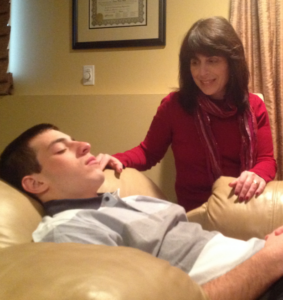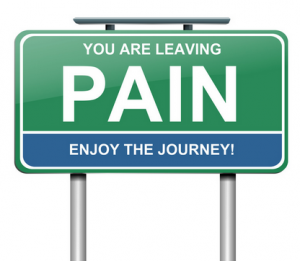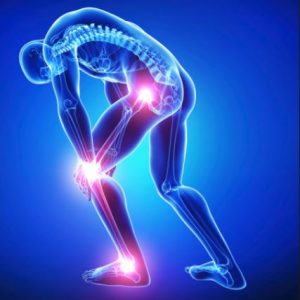
 There has been a great deal of published research into the use of hypnosis with fears and phobias. Occasionally, direct suggestions for relief of anxiety or phobias prove effective.
There has been a great deal of published research into the use of hypnosis with fears and phobias. Occasionally, direct suggestions for relief of anxiety or phobias prove effective.
When direct suggestions are ineffective, there are many other hypnotic techniques that may be helpful. Actually, simply the process of induction and deepening generally relieves anxiety.
Hypnotically-facilitated systematic desensitization, a neurolinguistic procedure, is very helpful. The individual learns to gain a sense of internal control over the fearful or anxiety-producing trigger.
Advantages of hypnotic desensitization over traditional behavioral desensitization include enhanced scene visualization and the ability to give posthypnotic suggestions to encourage behavioral responses to the situations that were imagined.
Mental rehearsal of successfully coping with tense situations is another method for treating anxiety and phobic disorders. When low self-esteem is determined to be an aspect of the problem, ego-strengthening methods may be employed.
Because hypnosis exploits the intimate connection between mind and body, it provides relief through improved self-regulation  and also beneficially affects the experience of self-mastery.
and also beneficially affects the experience of self-mastery.
Hypnosis may be used to age regress patients to experiences immediately before they began to feel anxious. In this way the sequence of reactions can be studied by the individual.
This may aid in pinpointing the situations that elicit anxiety as well as the internal dialogue and imagery that evoke problematic responses. Age regression to times prior to the development of the phobia, when the patient was coping successfully, provide a resource state that can be anchored and brought to consciousness in times of high stress.
Age regression in hypnotherapy provides access to identifying causative conflicts or past experiences that are beyond conscious awareness. When traumatic events are found to be associated with phobic reactions, it may be profitable to facilitate an age regression and abreact the feelings associated with the experience.
Hypnosis has proven effective in the management of preoperative and postoperative anxiety, including situations in which the patient is in a crisis period. This can also apply to the treatment of dental phobia.
One common example of how hypnosis or hypnotherapy can be used to treat anxiety is in work with medical conditions and treatments that characteristically evoke significant anxiety.
These include dental procedures, surgical and post-surgical situations, lumbar punctures and bone marrow aspiration, chronic headaches, cancer, burn pain, gastrointestinal disorders, nausea, respiratory disorders, tinnitus, and obstetrics/gynecology.
 One example is reducing anxiety caused by magnetic resonance imaging (MRI), a medical diagnostic procedure which requires a patient to lie in an enclosed space for about one hour.
One example is reducing anxiety caused by magnetic resonance imaging (MRI), a medical diagnostic procedure which requires a patient to lie in an enclosed space for about one hour.
This enclosure induces panic and claustrophobic responses in up to 10% of patients undergoing the MRI procedure. There have been many failed diagnostic studies due to patient intolerance, claustrophobia and panic. Hypnosis has been used successfully to alleviate these reactions.
It is interesting to note that phobic patients have been shown to be, on average, more hypnotizable than others. The essence of the phobic experience is not unlike that of the event of hypnosis, and the phobic experience might be a spontaneously occurring panic-filled trance-like or dissociative experience. Hypnotherapy assists the patient to learn more about his dissociative capacity and to learn to control it.
By: Diane Zimberoff

If you’re looking for a gentle way to reduce the pain that comes with chronic conditions like rheumatoid arthritis (RA) or osteoarthritis( OA), hypnosis may just do the trick. Studies show that more than 75% of people with arthritis and related diseases experience significant pain relief using hypnosis. Forget what you’ve seen in movies about hypnosis. Today’s practitioners are using it to give patients an additional tool to help manage their pain.
 Learning to Relax with Hypnosis
Learning to Relax with Hypnosis
Hypnosis isn’t about convincing you that you don’t feel pain; it’s about helping you manage the fear and anxiety you feel related to that pain. It relaxes you, and it redirects your attention from the sensation of pain. In a hypnosis session, which usually lasts 10-20 minutes, you will likely start by focusing on your breathing to help you relax.
Then the hypnotist will instruct you to imagine a pleasant place and describe it in detail, refocusing your attention from something that triggers negative emotions to something that will activate positive emotions, such as being at the beach.
If your mind is off to the beach, and you’re imagining the warmth of the sun, the cool of the breeze, the sand at your feet, you’ll be less focused on your pain – and ready for the indirect suggestion of how to react to pain in the future.
It might sound something like this: “You will continue to feel this same sensation of pain, but you’ll be much less distressed about it, much calmer, much more at ease, not worried about it.”
Practice Makes Perfect
Hypnosis isn’t a one-shot treatment. At first, it can be part of regular psychotherapy sessions in a doctor’s office. Hypnosis typically helps  relieve pain in just 4 to 10 sessions. But some people benefit faster and others not at all. The goal is to teach patients the technique so they can use it on their own when pain strikes.
relieve pain in just 4 to 10 sessions. But some people benefit faster and others not at all. The goal is to teach patients the technique so they can use it on their own when pain strikes.
Some practitioners create recordings for patients that they can play to lead themselves into the hypnotic process. Some patients prefer to come up with their own script and not rely on a recording or the therapist’s voice to activate the process when pain strikes and they need it.
Learning hypnosis takes practice, and some people learn it more easily than others. Practice when you feel little or no pain; when you’re in a lot of pain, it can be harder to do.
Hypnosis Works for Children
Hypnosis is a tool you also can give a child to help him take control. When he feels pain, he can do something about it immediately without having to wait until mom gets there with the pills or for the pills to take effect. Having hypnosis as a tool also helps eliminate stress that comes from not having control.
For children, creating an active mental escape may be necessary. Rather than relaxing at the beach with a book, a child may want to imagine playing on the playground or kicking a soccer ball down the field.
 Is Hypnosis Right for You?
Is Hypnosis Right for You?
Some people respond to hypnosis better than others, but there’s no harm in trying it. It has no side effects and if it doesn’t work for you, you can stop at any time. But many people report significant reduction in pain and gain a simple tool for easing it that they can use any time.
To find a qualified hypnotherapist, ask your doctor for a referral or contact the Society for Clinical and Experimental Hypnosis or the American Society for Clinical Hypnosis. Health insurance may cover hypnosis for pain therapy performed by a medical or psychological professional. (By: Jenny Nash // Arthritis.org)

 Our stomachs and intestinal systems are like a second brain – it isn’t the seat of consciousness, but it does respond to hypnosis.
Our stomachs and intestinal systems are like a second brain – it isn’t the seat of consciousness, but it does respond to hypnosis.
This “second brain” contains some 100 million neurons, more than in either the spinal cord or the peripheral nervous system. This multitude of neurons in the enteric nervous system enables us to “feel” what is going on in the inner world of our gut.
Think of the phrases we commonly use: gut instinct; butterflies in the stomach; that makes me sick to the stomach; and gut wrenching. Hypnosis can influence this “second brain” as effectively as any other neurological process.
Hypnosis and Heartburn
At least 60,000,000 Americans suffer from heartburn, sometimes the medicines work, sometimes not so well. Recently medical doctors have been turning to complementary approaches like hypnotism. This short NBC news broadcast shows why instead of reaching for TUMS you might consider hypnosis instead or in addition.
Hypnosis and Irritable Bowel Syndrome
Irritable Bowel Syndrome (IBS) is a medical condition and a complex set of gastrointestinal symptoms – it may affect as many as 20% of the population  in the United States. Symptoms include cramping, diarrhea (or constipation), pain, and bloating. Over 60% of sufferers are women. IBS is actually the second likely reason reported for missed days at work.
in the United States. Symptoms include cramping, diarrhea (or constipation), pain, and bloating. Over 60% of sufferers are women. IBS is actually the second likely reason reported for missed days at work.
Physicians will tell you they don’t know the causes of IBS: but they do know that IBS can be aggravated by stress and that there are some anatomical changes in the lining of the colon and to the nervous system of the colon associated with the condition. Diet can also influence IBS. Those who suffer from IBS know it is far more than a nuisance and can negatively impact quality of life.
The good news is that IBS symptoms respond to hypnosis and they often respond dramatically. Research is plentiful and convincing. It is so convincing that a leading health leader (Dr Adriane Fugh-Berman, MD, chair of the National Women’s Health Network) has stated that “hypnosis should be the treatment of choice for all severe cases of IBS.”
I have had the privilege of working with cancer patients in the complementary care program at Women and Infants often getting great results helping them reduce anticipatory nausea with self-hypnosis.
NBC News 2017

 Hypnosis has been used for centuries for pain control, including during the Civil War when Army surgeons hypnotized injured soldiers before amputations. Recent studies have confirmed its effectiveness as a tool to reduce pain.
Hypnosis has been used for centuries for pain control, including during the Civil War when Army surgeons hypnotized injured soldiers before amputations. Recent studies have confirmed its effectiveness as a tool to reduce pain.
Among the leading researchers in the field is Guy H. Montgomery, PhD, a psychologist who has conducted extensive research on hypnosis and pain management at Mount Sinai School of Medicine, where he is director of the Integrative Behavioral Medicine Program.
In one study, Montgomery and colleagues tested the effectiveness of a 15-minute pre-surgery hypnosis session versus an empathic listening session in a clinical trial with 200 breast cancer patients. The team reported that patients who received hypnosis reported less post-surgical pain, nausea, fatigue and discomfort.
The study also found that the hospital saved $772 per patient in the hypnosis group, mainly due to reduced surgical time. Patients who were hypnotized required less of the analgesic lidocaine and the sedative propofol during surgery. Journal of the National Cancer Institute (Vol. 99, No. 17)

 If you’ve ever read an article on your computer screen and stopped to realize you have no idea what you just read, you’ve experienced something similar to highway hypnosis.
If you’ve ever read an article on your computer screen and stopped to realize you have no idea what you just read, you’ve experienced something similar to highway hypnosis.
A commuter train engineer told investigators he was in a “daze” moments before the Dec. 1 derailment that killed four people in New York City. That could have been highway hypnosis, experts say.
“When we’re tired, effectively there’s a change in the state of our brain that results in that information just not getting to those centers where we actively, consciously process it,” said Sean Meehan, a University of Michigan kinesiology professor.
A person who has lapsed into highway hypnosis is experiencing slowed brain activity, Meehan said, meaning different parts of the brain aren’t communicating with one another as frequently as when the person is fully conscious. It’s actually similar to the brain activity of someone who is asleep, and is most likely to occur in a  driver who is tired, he said.
driver who is tired, he said.
As a result, the driver’s reaction time is slowed, he said.
“I’m sure most people experienced this on a long trip where they all of the sudden realize they really haven’t been aware of what they’re doing,” said Meehan, who is currently working with the Hyundai-Kia Technical Center to determine the feasibility of a device that would tell car drivers when their brain activity has slowed.
Going into this autopilot-like mode often happens on long, mundane highway drives with few turns or traffic signals, Meehan said. The driver usually can’t recognize highway hypnosis until his environment is somehow jostled — another car cuts him off or he hits a bump.
Drowsy driving results in more than 100,000 crashes a year, resulting in 1,550 deaths, according to the National Highway Traffic Safety Administration. Highway hypnosis often gets lumped into drowsy driving because it happens in tired drivers, Meehan said.
 Still, a highway isn’t the only place it can happen. It can happen on a train, Meehan said, though it hasn’t been blamed for any other train accidents to his knowledge. It can also happen at your desk when your eyes gloss over a work document and you realize you didn’t comprehend it.
Still, a highway isn’t the only place it can happen. It can happen on a train, Meehan said, though it hasn’t been blamed for any other train accidents to his knowledge. It can also happen at your desk when your eyes gloss over a work document and you realize you didn’t comprehend it.
To prevent highway hypnosis on the road, Meehan suggests taking a break every 90 minutes or so, or — if you’re lucky enough to be driving with someone else — switch drivers.
Listening to the radio isn’t enough to prevent this daze, and can even contribute to it, he cautioned. And always get at least six hours of sleep the night before a long trip, he said.
The University of Kansas Transportation Center published guide for rural transit drivers to avoid driver fatigue. In addition to Meehan’s tips, it suggests keeping the vehicle cool and maintaining good posture to stay alert.
By Sydney Lupkin

 There has been a great deal of published research into the use of hypnosis with fears and phobias. Occasionally, direct suggestions for relief of anxiety or phobias prove effective.
There has been a great deal of published research into the use of hypnosis with fears and phobias. Occasionally, direct suggestions for relief of anxiety or phobias prove effective. and also beneficially affects the experience of self-mastery.
and also beneficially affects the experience of self-mastery. One example is reducing anxiety caused by magnetic resonance imaging (MRI), a medical diagnostic procedure which requires a patient to lie in an enclosed space for about one hour.
One example is reducing anxiety caused by magnetic resonance imaging (MRI), a medical diagnostic procedure which requires a patient to lie in an enclosed space for about one hour.
 Learning to Relax with Hypnosis
Learning to Relax with Hypnosis Is Hypnosis Right for You?
Is Hypnosis Right for You?
 Our stomachs and intestinal systems are like a second brain – it isn’t the seat of consciousness, but it does respond to hypnosis.
Our stomachs and intestinal systems are like a second brain – it isn’t the seat of consciousness, but it does respond to hypnosis. in the United States. Symptoms include cramping, diarrhea (or constipation), pain, and bloating. Over 60% of sufferers are women. IBS is actually the second likely reason reported for missed days at work.
in the United States. Symptoms include cramping, diarrhea (or constipation), pain, and bloating. Over 60% of sufferers are women. IBS is actually the second likely reason reported for missed days at work.
 Hypnosis has been used for centuries for pain control, including during the Civil War when Army surgeons hypnotized injured soldiers before amputations. Recent studies have confirmed its effectiveness as a tool to reduce pain.
Hypnosis has been used for centuries for pain control, including during the Civil War when Army surgeons hypnotized injured soldiers before amputations. Recent studies have confirmed its effectiveness as a tool to reduce pain.
 If you’ve ever read an article on your computer screen and stopped to realize you have no idea what you just read, you’ve experienced something similar to highway hypnosis.
If you’ve ever read an article on your computer screen and stopped to realize you have no idea what you just read, you’ve experienced something similar to highway hypnosis. driver who is tired, he said.
driver who is tired, he said. Still, a highway isn’t the only place it can happen. It can happen on a train, Meehan said, though it hasn’t been blamed for any other train accidents to his knowledge. It can also happen at your desk when your eyes gloss over a work document and you realize you didn’t comprehend it.
Still, a highway isn’t the only place it can happen. It can happen on a train, Meehan said, though it hasn’t been blamed for any other train accidents to his knowledge. It can also happen at your desk when your eyes gloss over a work document and you realize you didn’t comprehend it.







